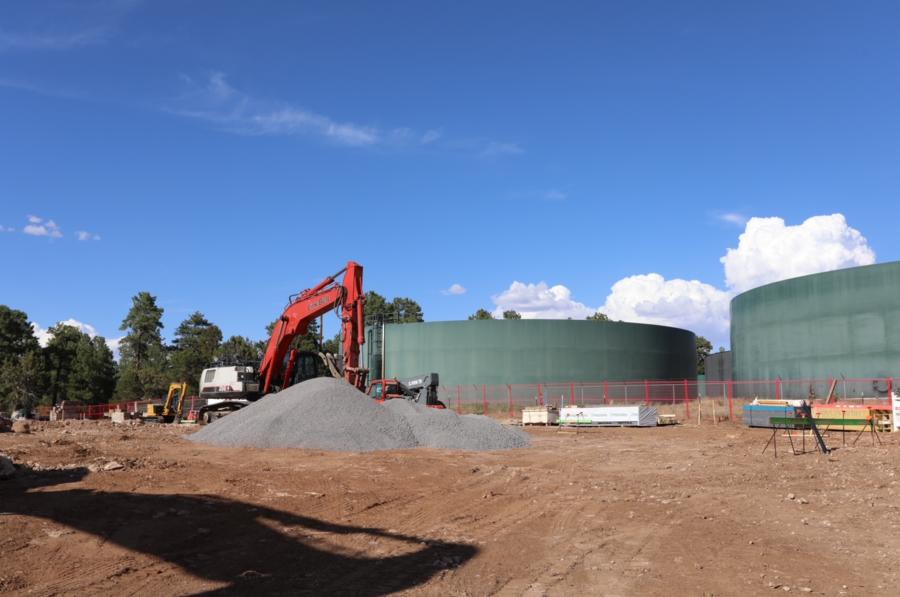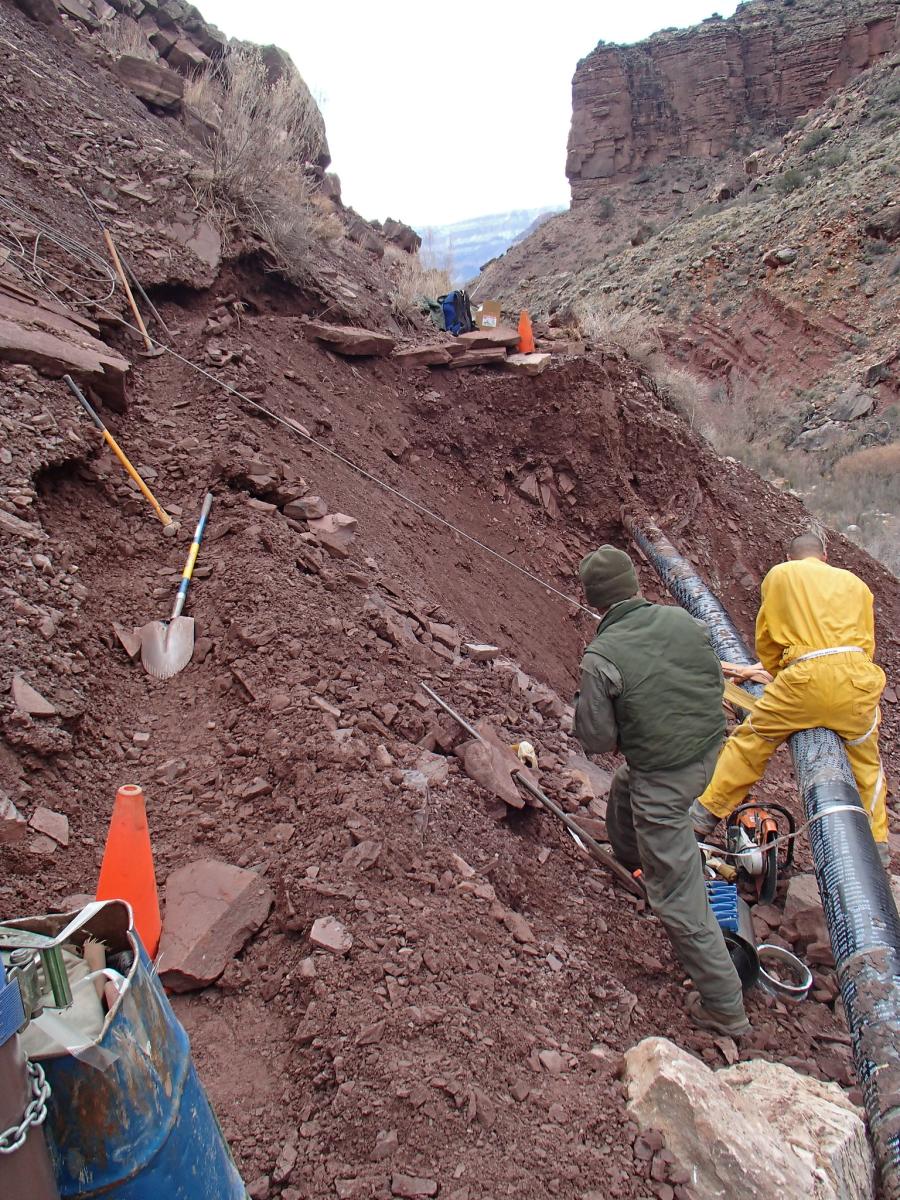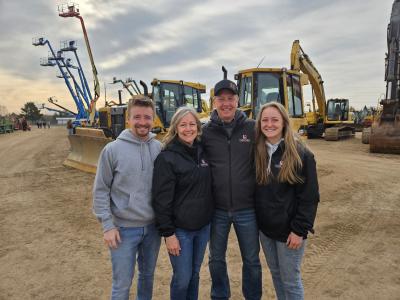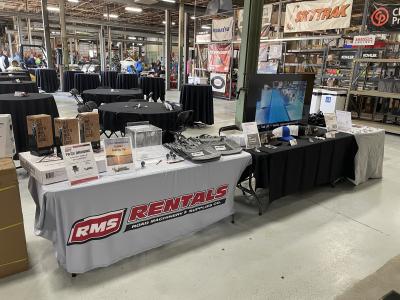Construction crews are in the process of excavating and putting in base aggregate at the South Rim Water Treatment Plant construction site — part of the $200 million Transcanyon Waterline project — at Grand Canyon National Park.
(National Park Service/L. Daniels photo)
Talk about your humungous projects.
Work is now under way to replace the Transcanyon Waterline (TCWL), a 53-year-old, 12.5-mi. long, 6-to-8 in. diameter aluminum pipe buried below a hiking trail in the Grand Canyon National Park that is considered the mighty mainstay of the park's water system.
The water originates from the Roaring Springs source below the North Rim of the Grand Canyon. From there, the water moves via the TCWL to Phantom Ranch, across the Colorado River and up to the Havasupai Gardens pump station and, ultimately, to the South Rim.
The waterline provides 190 million gal. of water to as many as 5 million visitors annually and 2,500 residents in the Cross Canyon Corridor and South Rim area. It also provides water to facilities and more than 800 historic buildings, including administrative and operations buildings, residential housing for staff, the Grand Canyon school, hotels/lodges, campgrounds and water-filling stations.
That's a lot of heavy lifting for a structure that was completed sometime around the first Earth Day in 1970. In fact, since 2010, there have been more than 85 major breaks in the line, with each resulting in water-delivery disruptions.
"The TCWL is beyond its expected useful life and requires expensive and continuous inner canyon maintenance work to repair leaks," said Rob Parrish, division chief of the Division of Planning, Environment and Projects at Grand Canyon National Park
So, instead of paying for unbudgeted repairs ranging from thousands up to hundreds of thousands of dollars and having staff work in hazardous situations, the National Park Service awarded a $208 million construction contract in March to Stronghold Engineering Inc. of Perris, Calif.
Construction began shortly thereafter and is projected to wrap up in October 2026. Overall costs of the water-delivery system project, which took about 10 years to design, will be calculated after the project is completed.
Project Challenges, New Construction
The overall design and the materials used are the main differences between the existing and new TCWL.
"Since pipeline breaks are the main cause for water delivery failures within the park, selecting the right materials was a critical decision in the design process," said Parrish. "The original pipe material is aluminum, which is easier to haul into the inner canyon due to its weight-to-size ratio. The material contributes to the degradation of the waterline and frequent structural breaks due to the extreme environmental conditions of the inner canyon."
Flexsteel pipe was selected to replace the aluminum pipe because of the balanced tradeoff between weight, durability and the strength of the material. The pipe is being sliplined into the Bright Angel Trail section of the waterline from the South Rim to the Havasupai Garden Campground.
The new design calls for the relocation of the water intake, moving from Roaring Springs to Bright Angel Creek. The relocation will eliminate nearly 7 mi. of the pipeline north of Phantom Ranch in an area known as "the box," where most breaks occur due to falling rocks and extreme temperatures that cause the aluminum to deteriorate.
Then there are the logistical challenges stemming from work in the inner canyon.
"All the equipment and materials for the waterline, distribution systems, Phantom Ranch water treatment plant and inner canyon support facilities need to be airlifted through controlled air space into the inner canyon," Parrish explained. "Most of the materials for this work were ordered earlier this summer to account for long lead times, ensuring that the contractor can transfer them during set timeframes. Plans call for the transfer of multiple sling loads of equipment during the set timeframes to minimize use of the heavy-lift helicopters, since those are reserved during wildfire seasons for emergency operations."
The "sequenced construction timeline," according to Parrish, includes the following:
- Construction of an auxiliary hangar, helicopter landing pad and contractor support area at the park helicopter base;
- Construction of a 1 million-gallon per day water treatment plant at the South Rim and a smaller water treatment plant at Phantom Ranch;
- Replacement of the water distribution system at Havasupai Gardens;
- Replacement of approximately 3 mi. of waterline and upgrading approximately 3 mi. of electrical supply line from Havasupai Gardens to Phantom Ranch;
- Construction of a water intake system and pumping station in the Phantom Ranch area;
- Replacement of the water and electrical distribution systems at Phantom Ranch.
Additional challenges also included:
- Installation of the pipe from Plateau Point down the steep canyon walls to Phantom Ranch required teams to rappel down to install pipe anchors to secure the pipe to the canyon wall;
- Need for water remains while work to replace the pipeline continues, resulting in a bypass to ensure water flow to the inner canyon and South Rim;
- Communication between the contractor and NPS staff remains critical as workers complete sections, requiring certain trails to be temporarily closed.
Planning, Preparation
On average, there are approximately 100 construction personnel, including subcontractors, at various project construction sites in the park, helping to make upfront and ongoing logistical planning a key factor in remaining on schedule.
"Some of the planning includes factoring in weather delays and no-fly days because the weather could shift," said Parrish. "Part of that planning includes contingencies to shift workers to other project areas to keep work going and to complete tasks within the allotted timeframes. Moreover, ongoing coordination between the contractor and NPS staff enables construction progress and supports park operations while providing safe experiences for visitors." CEG
Today's top stories

























